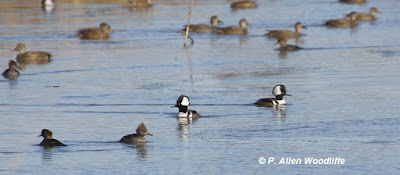I've been out and about a little since my last post. The former Dover Twp between Chatham, Mitchell's Bay and Lake St. Clair is often worth checking at this time of year. Snowy Owls are arriving in larger numbers, at least for now. On the day I was out looking, I came across 5 of them. Whether they stay for most of the winter or keep moving farther south, remains to be seen. There have been 4 or more along Lagoon Road, a bit north of Rondeau Bay as well.
Most of the Snowies that I have seen tend to be out in the partial shelter of a recently harvested cornfield.
Once in awhile, one is a little closer to the road.
While out looking for Snowies, I came across a large number of Tundra Swans. Large numbers of them have been a little slower arriving in the Lake St. Clair area than some years, it seems. On this day I saw an estimated 7000 or more in several fields. This first photo is of a very small portion of one of the larger fields.
They were frequently on the move, seeming to be startled when vehicles slowed down or ATVs roared by.
I looked for other birds mixed in such as Ross's Goose or Snow Goose, but did not see any at the time. However there have been Trumpeter Swans hanging out in southern Chatham-Kent in the last few weeks, sometimes at the Blenheim Sewage Lagoons or McGeachy Pond or somewhere in between. These were photographed at McGeachy Pond one cloudy, late afternoon.
A Great Blue Heron was at McGeachy Pond as well, taking shelter from the brisk westerly wind.
The forested landscapes are generally quiet these days, although they are still attractive in their own right.
 |
| Harrison Trail |
 |
| Southeast Oak Savanna (Rondeau) |
 |
| McKerral Woods |
Bright red berries such as those in the first photo, are appropriately called Winterberry (Ilex verticillata). This native species is widespread but not abundant.
Unfortunately another bright red berry producing shrub is much more abundant but not native. It is Japanese Barberry and is a real problem species in our landscapes.
Northern Saw-whet Owls have been migrating through the area from their northern haunts. They can be difficult to find, however. This next photo shows one that I was able to find, but only due to some kinglets and chickadees that were heard scolding it, which alerted Steve Charbonneau to find it and pass on the directions to others. Even with the very good directions it was hard to pick out quite high in this White Pine of the Rondeau campground. This bird was an estimated 25 feet up, much higher than they are normally found.
Of course bird feeding areas are often the best place to seek out birds, and the feeders at Rondeau are worth checking out at anytime.
Winter finches, including Evening Grosbeaks, are irregular winter visitors to southwestern Ontario. This fall and winter seems to be one of those times that local birders look forward to, and at least a few of these grosbeaks have been sighted over the last couple of weeks or so. I photographed these at the drinking pool of the Rondeau Visitor Centre.
Pine Siskins are another irregular winter visitor. Here are a few feasting on the niger seed at the Visitor Centre.
Red-breasted Nuthatches are another, mostly winter visitor.
One has to work a little harder to find birds this time of year but the results, even if it is just being out for a nice long walk, can be quite satisfying.

















































